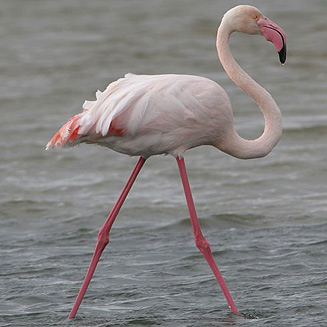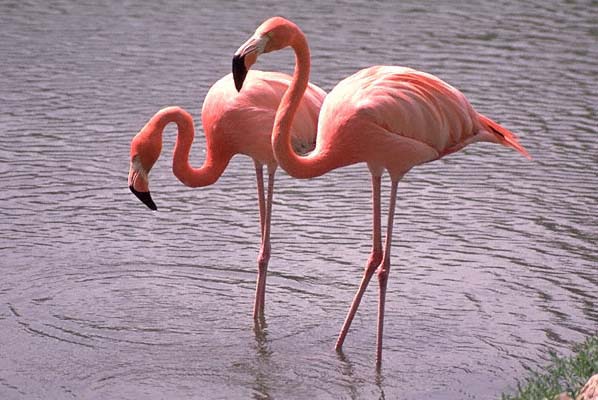
Phoenicopterus ruber
TAXONOMY
Phoenicopterus ruber Linnaeus, 1758, Bahamas. Two subspecies:
P.r. ruber and P.r. roseus.
OTHER COMMON NAMES
English: Caribbean, West Indian flamingo, rosy flamingo;
French: Flamant rose; German Rosaflamingo; Spanish: Flamenco
Comъn.
PHYSICAL CHARACTERISTICS
47–57 in (120–145 cm) 4.6–9.0 lb (2.1–3.4 kg); female approximately
10–20% smaller than male. Largest of the flamingos,
adults are rosy red (Caribbean population) or whitish tinged with
pink (European-African-Asian population) with brighter pink on
the wings. The flight feathers are black. The bill is pink with a
black tip, and legs are pink with darker pink joints. Hatchling is
dark or light gray down with bright red legs and straight red bill.
Juvenile is gray-brown, acquiring pale pink upper wing panel and
pink tinge to gray legs and bill at 11 months; at four years, body
plumage and lower portion of bill still grayer than adults.
DISTRIBUTION
P. r. ruber: Galбpagos and Caribbean; P. r. roseus: North, West,
East, and South Africa, southern Europe, Middle East, southwest
Asia and Pakistan, India, and Sri Lanka.
HABITAT
Shallow saline and alkaline lakes and lagoons.
BEHAVIOR
Gregarious, with group displays involving ritualized movements
of head and wings, accompanied by loud calls. In flocks
of a few hundred to over one million.
FEEDING ECOLOGY AND DIET
Sieves aquatic invertebrates, seeds, algae, and diatoms from
shallow water and mud.
REPRODUCTIVE BIOLOGY
Lays single egg (large, elongated, white, and chalky with reddish
yolk) on mud nest close to or in shallow water, the time
of breeding being dictated by rainfall rather than seasons.
Nests in dense colonies, up to tens or hundreds of thousands
of pairs. Incubation period 27–31 days; fledging 65–90 days.
Both parents incubate and care for young, which gather into
groups. Productivity very variable, with complete failures in
some years. Age of first breeding normally five or six years.
CONSERVATION STATUS
Not threatened. Has declined in the Caribbean but increased
in southwestern Europe. Elsewhere, very numerous, though
subject to wide fluctuations in numbers based on rains and
breeding success.
SIGNIFICANCE TO HUMANS
Sometimes hunted for food or sport, e.g., in Egypt.
Other popular Animals
Photo Gallery of - Greater flamingo




 Animalia Life
Animalia Life